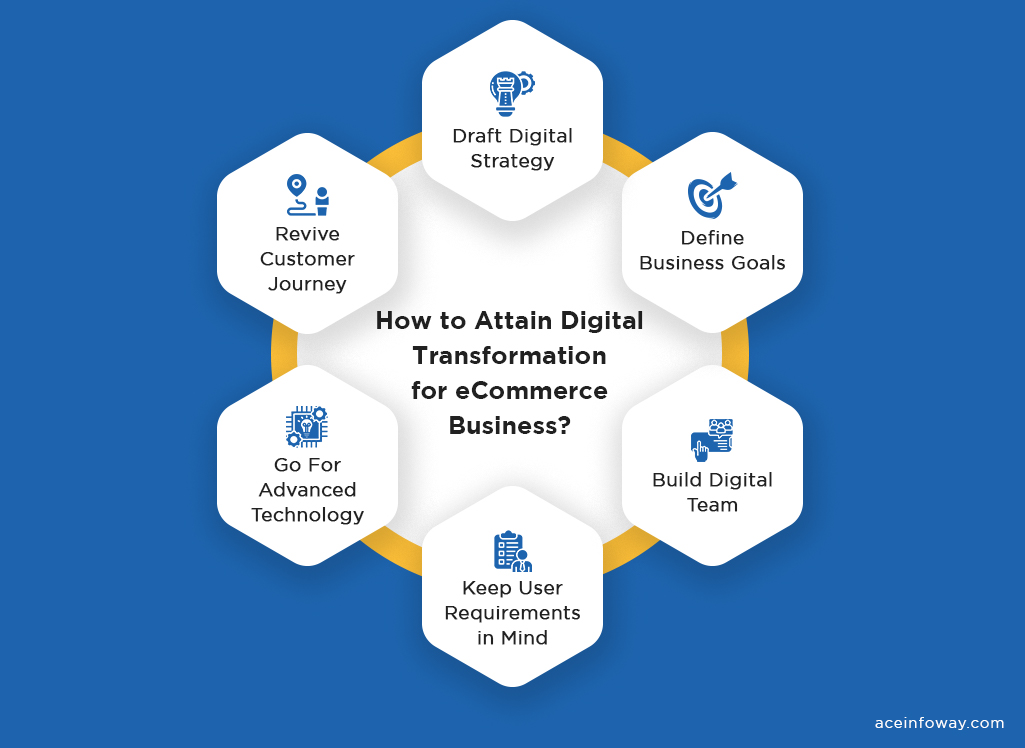Table of Contents
Charles Darwin’s theory of evolution suggests that humans got evolved from ape-like ancestors. Darwin defines evolution as “descent with modification”. It means species change over time, give rise to new species and share a common ancestor.
Our shopping experience and pattern also got evolved with “eCommerce digital transformation” with the advent of online shopping. From brick-and-mortar shops, we evolved to shop from online stores and eCommerce platforms. The suggestions and advice from friends and relatives about the quality, from where to shop, and what to shop, got replaced by online reviews, stars, and recommendations.
As per the data, by 2023 businesses undergoing digital transformation are estimated to contribute a portion of 53.3 trillion USD to the global GDP. More and more businesses are approaching eCommerce development services providers for digital transformation to not miss the opportunity.

eCommerce Trends 2023 [eBook]
Get your free copy
In this post, we are sharing insights about the benefits, driving factors, processes, and importance of digital transformation in eCommerce. But first, let’s understand briefly what digital transformation is.
What is Digital Transformation in eCommerce?
“Digital transformation of business includes everything from IT modernization to digital optimization, to the invention of new digital business models.” In layman’s language, it is a process of using digital technology to develop new or enhanced business processes, products, and services.
With the integration of artificial intelligence, machine learning, and digital awareness, it’s anticipated that with digital transformation, eCommerce is going to experience a significant paradigm shift.
The digital transformation in eCommerce is not just limited to technology but also about financial, cultural, and process readiness to enhance the customer experience and boost the growth rate of the business.
Factors Driving Digital Transformation in eCommerce
1) Customer Experience Enhancement
Earlier customers used to plan shopping on weekends but now they are doing it from home, office, metros, cafe and not where. The digital transformation of businesses has empowered customers to shop anything from anywhere, anytime, return, exchange, and cancel orders.
Now, as more and more customers are inclined towards online shopping, businesses need digital transformation to make users more connected and comfortable with online shopping. And it can be done by the list given below:
- Easy Checkout Process
- Impeccable UI/UX and CX
- Quality Product and Service
- Standard Customer Care Service
- User-friendly intuitive accessibility
- Robust Security and High-performing Platform (App or Website)
- Relevant Product Recommendation For Personalized Experience
2) Ever-increasing Customer Demands
Meeting customer demands and expectations for quick and more personalized service is the need of an hour for the eCommerce sector. And what can bridge the customer expectations from a service provider? The answer is digital transformation in eCommerce and the application of planning by eCommerce strategists.
One of the main reasons for the rise in online shopping is the convenience and comfort that comes with it. So, below are the reasons for the rise in online shopping demanding eCommerce digital transformation.
- Time-Saving
- Better Pricing
- Easy Comparison
- One-Stop Solution
- Multiple Payment Modes
- Easy Pick-Up and Delivery Options
- Can Be Ordered From Anywhere and Anytime
- No Need Of Strolling From One Shop To Another
- You Don’t Need To Drive To A Shopping Mall Or Store
3) Direct-to-Consumer (DTC) Strategies
More and more organizations are switching to direct-to-consumer(DTC) strategy for many good reasons and business digital transformation can make the execution of this strategy easy and effective.
Today, companies want to have direct interaction with customers to enhance customers’ shopping experience. This strategy works two ways- beneficial for both- the customer and the company. The benefits of the DTC strategy are:
- Can Offer Better Pricing
- No Online Aggregator Needed
- Direct Interaction with the Customer
- Competitive Advantage In The Market
- Improved and Personalized Communication
- Better Control Over Brand Management and Service
4) Accurate Delivery Systems
Quick delivery and easy return is the factor that can make or break the loyal customer base. The overall customer experience with online shopping depends on how accurate the delivery system is and how the eCommerce store facilitates the return.
Having a streamlined delivery and return process is one of the factors driving eCommerce to undergo digital transformation.
Online shopping has made it easy for customers to return the product easily as well as quickly, in case they receive a wrong or defective product. With increasing demand, customers want the delivery of the right product at the right time.
5) Strong Online Presence
The number of smartphones, tab, and internet users is increasing day by day. With the escalating number of smartphone users, more and more businesses are inclining towards eCommerce.
The worldwide retail eCommerce sales amounted to approximately 5.2 trillion U.S. dollars in 2021. Market expert forecasts, worldwide retail eCommerce sales to grow by 56 percent by next year and might reach about 8.1 trillion dollars by 2026.
It is essential to make a solid online presence before your competitors make it and reach your target audience before you do. And to make a remarkable digital presence businesses need to undergo digital transformation to cater to the best quality online service and enhance customer experience. This will eventually help to grow and achieve business goals and objectives.
How is Digital Transformation Revolutionizing eCommerce?
Digital transformation is fundamentally changing the way eCommerce operates by leveraging advanced technologies and digital capabilities. Here’s how digital transformation is revolutionizing eCommerce:
💡 AR Assistance: Augmented Reality (AR) has revolutionized the shopping experience and decision-making process of customers. AR helps customers in making informed decisions and experience the product virtually through detailed visuals. From furniture to retail to the clothing industry AR is a significant part of eCommerce digital transformation.
Customers can virtually try on clothes, place furniture in their homes, or explore products in 360-degree views before making a purchase. If you want to offer a 360-degree view of the products to your customer on your online store then you can use this plugin for a 360-degree view in your eCommerce website.

💡 Personalized Shopping Experience: Leveraging AI and machine learning, eCommerce businesses can provide highly personalized shopping experiences. They can analyze customer behaviors, purchase history, and preferences to show targeted product recommendations, improving customer satisfaction and increasing sales.
💡 Improved Customer Service: AI-powered chatbots and virtual assistants can offer 24/7 customer service, answering common queries, providing product information, and guiding customers through their purchase journey. This improves the customer experience by providing immediate assistance and response.
AI is not only used in customer service but also managing inventory, predicting demand, personalizing customer experience, and detecting fraud. AI algorithms are powerful tools that help eCommerce businesses operate more efficiently and effectively.
💡 Omni-channel Presence: Digital transformation allows businesses to maintain a consistent presence across multiple channels, including websites, mobile apps, social media, and physical stores. This omnichannel approach allows customers to interact with the brand and make purchases in a way that suits them best.
💡 Smart Merchandising: Algorithm-based merchandise operations helps in planning operational costs, logistical challenges, and inventory management to meet customers’ expectations related to delivery and return.
Digital transformation in business can help it in optimizing a store’s inventory based on location, demands, and product availability. This can also help in deciding the price and promotion strategy as well as the method.
💡 Automated Marketing & Seamless Payment: Digital transformation enables businesses to automate their marketing efforts. Email marketing, social media posts, and other promotional activities can be automated and personalized to reach the right customer at the right time.
Digital transformation in eCommerce has led to the emergence of various digital payment options. From digital wallets and UPI to cryptocurrency, businesses can now offer multiple payment options to cater to the preferences of different customers.
💡 Advanced Analytics: The use of big data and advanced analytics allows eCommerce businesses to derive insights about customer behavior, market trends, and business performance. This helps in strategic decision-making, optimizing marketing campaigns, and predicting future trends.
Business digital transformation is an ongoing journey as technologies continue to evolve. The key is to adapt to these digital trends to stay competitive and meet the changing needs and expectations of customers.
How to Attain Digital Transformation for eCommerce Business?

🎯 Draft Digital Strategy: Develop a strategy for a digital transformation in business keeping the business goals, customer expectations, target audience, and latest trends at the center. This strategy will help you in planning and executing the digital transformation in eCommerce.
🎯 Define Business Goals: A clear business goal can help you make eCommerce digital transformation more effective. The factors that complement your business goals are:
- Easy Checkout
- Robust Digital Infrastructure
- Technological Advancement
- Enhanced Customer Experience
- Impeccable and Flawless Logistic
- Advanced Inventory Management
🎯 Build Digital Team: Either you can outsource a digital team or build an in-house team that can provide you with eCommerce development services. Ensure, that your team includes a talent that can meet your requirements and expectations for transformation.
🎯 Keep User Requirements in Mind: Thorough assessment of organizational infrastructure is required before undergoing digital transformation in eCommerce. End users are the one who gives final judgment about the product or service delivered. So, digital transformation must be done by prioritizing user requirements.
🎯 Go For Advanced Technology: Make no stone turn around when it comes to technology stack for digital transformation in business. Integrate the most advanced technology, tools, and features. But, don’t follow the flock blindly, make intelligent choices considering your business goals, business strategy, target audience, and customer’s requirements.
🎯 Revive Customer Journey: Try to provide an experience that feels real, more personalized, and relevant to the customers. AR, VR, AI, machine learning, and other elements can help revamp customers’ shopping journeys through eCommerce digital transformation.

eCommerce Trends 2023 [eBook]
Get your free copy
Conclusion
Digital transformation of business is indeed crucial to grow and stand the competition. In this era of digitization where most businesses are making a digital presence, it is not a good idea to hold and miss the opportunity. From technological infrastructure to business culture, inclusive of the entire system gets revamped with eCommerce digital transformation for better business operations and enhanced customer experience. In case, if you want your eCommerce business to undergo digital transformation and looking for an experienced team to make it happen strategically, please contact us for eCommerce development services.


























